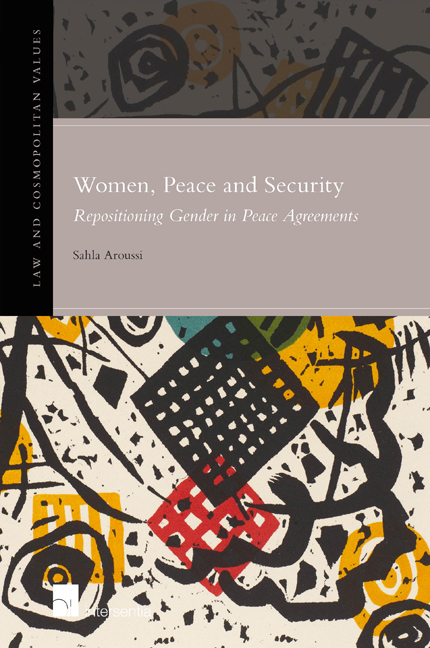Book contents
- Frontmatter
- Acknowledgements
- Contents
- List of Abbreviations
- List of Tables and Figures
- Introduction
- Chapter 1 The United Nations Resolutions on Women, Peace and Security
- Chapter 2 The Gender of Peace Agreements
- Chapter 3 Overview of Gender Provisions in Peace Agreements
- Chapter 4 Women's Political Participation in Peace Agreements
- Chapter 5 Gender-Based Violence
- Chapter 6 Perspectives from the Field
- Conclusion
- References
- Law and Cosmopolitan Values
- Instructions to authors
Chapter 6 - Perspectives from the Field
Published online by Cambridge University Press: 12 December 2017
- Frontmatter
- Acknowledgements
- Contents
- List of Abbreviations
- List of Tables and Figures
- Introduction
- Chapter 1 The United Nations Resolutions on Women, Peace and Security
- Chapter 2 The Gender of Peace Agreements
- Chapter 3 Overview of Gender Provisions in Peace Agreements
- Chapter 4 Women's Political Participation in Peace Agreements
- Chapter 5 Gender-Based Violence
- Chapter 6 Perspectives from the Field
- Conclusion
- References
- Law and Cosmopolitan Values
- Instructions to authors
Summary
In Chapter 3 I established that out of the 112 agreements in the database 49 included references to women and gender issues and 63 agreements did not. The analysis in Chapters 4 and 5 demonstrated that the provisions addressing gender concerns in peace agreements also remain largely inadequate. This chapter, relying on expert opinions, aims to uncover some of the reasons behind the limited implementation of the UN resolutions on WPS in peace agreements and to draw key recommendations for maximising the impact of the resolutions on the ground. The chapter is based on 12 interviews conducted with key elite experts involved in the field of peacemaking. The views of the experts are particularly useful to understand the dynamics of peace negotiations and the challenges for the implementation of the UN agenda on WPS on the ground. As I explained in Chapter 2, the environment of formal peace negotiations is generally elitist and exclusionary consisting mainly of military leaders and government representatives engaged in direct or indirect talks with the help of third parties. Outside the parties to the conflict, those involved in the negotiation, mediation and facilitation of peace agreements generally carry prestige, influence and political weight. Consequently, some of the participants in this research would form part of what Zuckerman has termed the ‘ultra-elite’. Because of their insider experience, talking to the elites is a very efficient and concentrated method of gathering good quality data. In this research I define ‘experts’ as those professional elites who are or have been closely involved in the formal negotiations of one or more peace agreements and who are working or have worked in the planning and supporting of mediation of formal peace processes and peacemaking activities. As I have previously mentioned, in order to satisfy the ethical requirement of this research, all the participants in this research have been anonymised. The interviews were conducted in 2009 and hence the analysis in this chapter is generally focused on resolutions 1325 and 1820 rather than on the more recent resolutions on women, peace and security.
- Type
- Chapter
- Information
- Women, Peace, and SecurityRepositioning gender in peace agreements, pp. 257 - 292Publisher: IntersentiaPrint publication year: 2015

